Progress Lighting P250075-163-WB User manual
- Category
- Household fans
- Type
- User manual
This manual is also suitable for

Ceiling Fan Installation Manual
P250075
93157893_C

Date Purch as ed
Store Pu rch as ed
Mo d el No .
Serial No.
Vendo r No.
UPC
109226
Limited Lifetime Warranty
Progress Lighting fan motors are warranted to the original purchaser to be free of electrical and/or mechanical defects for so
long as the original purchaser owns the fan. Pull chain switches, reverse switches, capacitors and metal finishes are warranted to
be free from defects in materials or workmanship for a period of 1 year from the date of purchase. Warping of wooden or plastic
blades is not covered by this warranty nor is corrosion and/or deterioration of any finishes for fans installed within ten miles of
any sea coast. Extended warranties for ENERGY STAR® qualified products may apply.
Progress Lighting ceiling fans with built-in LED light sources, when properly installed and under normal conditions of use, are
warranted to be free from defects in material and workmanship which cause the light sources to fail to operate in accordance
with the specifications for (i) five (5) years from the date of purchase on the LED Light modules and electrical components for
fans used in single family residences, and (ii) three (3) years from the date of purchase on the LED Light modules and electrical
components for fans used in multi-family or commercial applications. LED bulbs supplied by Progress Lighting carry no
warranty other than manufacturer’s warranty. Non-LED bulbs carry no warranty.
With proof of purchase, the original purchaser may return the defective fan to the place of purchase during the first 30 days for
replacement. After 30 days, the original purchaser MUST contact Progress Lighting at (864) 678-1000 for repair or replacement
which shall be determined in Progress Lighting’s sole discretion and shall be purchaser’s sole and exclusive remedy.
Labor and Shipping Excluded. This warranty does not cover any costs or fees associated with the labor (including, but not
limited to, electrician’s fees) required to install, remove, or replace a fan or any fan parts.
This warranty shall not apply to any loss or damage resulting from (i) normal wear and tear or alteration, misuse, abuse or
neglect, or (ii) improper installation, operation, repair or maintenance by original purchaser or a third party, including without
limitation improper voltage supply or power surge, use of improper parts or accessories, unauthorized repair (made or
attempted) or failure to provide maintenance to the fan.
THE FOREGOING WARRANTIES STATE PROGRESS LIGHTING’S ENTIRE WARRANTY OBLIGATION AND
ORIGINAL PURCHASER’S SOLE AND EXCLUSIVE REMEDY RELATED TO SUCH PRODUCTS. PROGRESS
LIGHTING IS NOT RESPONSIBLE FOR DAMAGES (INCLUDING INDIRECT, SPECIAL, INCIDENTIAL OR
CONSEQUENTIAL), DUE TO PRODUCT FAILURE, WHETHER ARISING OUT OF BREACH OF WARRANTY,
BREACH OF CONTRACT, OR OTHERWISE. THIS WARRANTY IS GIVEN IN LIEU OF ALL OTHER WARRANTIES,
WHETHER EXPRESSED OR IMPLIED, INCLUDING THOSE OF MERCHANTABILITY, FITNESS FOR A PARTICULAR
PURPOSE OR NONINFRINGEMENT.
Some states do not allow limitations on how long an implied warranty lasts or the exclusion or limitations of incidental or
consequential damages, so the above limitations and exclusions may not apply to you. This warranty gives you specific rights
and you may have other rights which vary from state to state.
785247264865
785247264872
785247264889
P250075

Table of Contents
Safety Rules.....................................................................................................................................................................................
Unpacking Your Fan .......................................................................................................................................................................
Installing Your Fan .........................................................................................................................................................................
Installing the Light Kit and Glass Shade .......................................................................................................................................
Operating Your Transmitter ..........................................................................................................................................................
Care of Your Fan ...........................................................................................................................................................................
Troubleshooting ............................................................................................................................................................................
Specifications ................................................................................................................................................................................
1.
2.
3.
8.
9.
11.
12.
13.

1. Safety Rules
1. To reduce the risk of electric shock, insure electricity has been turned off
at the circuit breaker or fuse box before beginning.
2. All wiring must be in accordance with the National Electrical Code and
local electrical codes. Electrical installation should be performed by a
qualified licensed electrician.
3. WARNING: To reduce the risk of electrical shock and fire, do not use
this fan with any solid-state fan speed control device.
4. WARNING: To reduce the risk of fire, electric shock, or personal injury,
mount to outlet box marked "Acceptable for Fan Support of 15.9 kg (35 lbs.)
Or Less" and use mounting screws provided with the outlet box. Most outlet
boxes commonly used for the support of light fixtures are not acceptable for
fan support and may need to be replaced. Due to the complexity of the
installation of this fan, a qualified licensed electrician is strongly
recommended.
WARNING
TO REDUCE THE RISK OF FIRE, ELECTRIC SHOCK OR PERSONAL
INJURY, MOUNT FAN TO OUTLET BOX MARKED ACCEPTABLE FOR
FAN SUPPORT.
5. The outlet box and support structure must be securely mounted and
capable of reliably supporting a minimum of 35 lbs (15.9 kg) or less.
Use only UL-listed outlet boxes marked FOR FAN SUPPORT.
6. The fan must be mounted with a minimum of 7 ft (2.1m) clearance from
the trailing edge of the blades to the floor.
7. To operate the reverse function on this fan, press the reversing button while
the fan is running.
8. Avoid placing objects in the path of the blades.
9. To avoid personal injury or damage to the fan and other items, be
cautious when working around or cleaning the fan.
10. Do not use water or detergents when cleaning the fan or fan blades. A
dry dust cloth or lightly dampened cloth will be suitable for most
cleaning.
11. After making electrical connections, spliced conductors should be
turned upward and pushed carefully up into the outlet box. The wires
should be spread apart with the grounded conductor and the
equipment-grounding conductor on one side of the outlet box.
12. Electrical diagrams are for reference only. Light kits that are not packed
with the fan must be UL Listed and marked suitable for use with the
model fan you are installing. Switches must be UL General Use
Switches. Refer to the Instructions packaged with the light kits
NOTE
READ AND SAVE ALL INSTRUCTIONS!
WARNING
TO REDUCE THE RISK OF PERSONAL INJURY, DO NOT BEND THE
BLADE ARMS (ALSO REFERRED TO AS BRACKETS) DURING
ASSEMBLY OR AFTER INSTALLATION. DO NOT INSERT OBJECTS IN
THE PATH OF THE BLADES.

Unpack your fan and check the contents. You should have the following items:
Unpacking Your Fan 2.
14. Loose parts bag containing:
a. Mounting hardware
Wire nuts (3)
b. Blade attachment hardware
13 screws with lock washer
1. Fan blades (4)
2. Blade support plates (4)
3. Canopy assembly
4. Ball/downrod assembly
5. Coupling cover
6. Fan motor assembly
7. Mounting plate
8. Light kit
9. Glass shade
10. 7 Watt LED bulb
11. Transmitter incl. holder + 2 mounting screws
12. 12V battery
13. Balancing kit
4
5
1
2
39
10
11
6
8
7
14
13
12
b
a

Tools Required
Phillips screw driver, straight slot screw driver,
adjustable wrench, step ladder, and wire cutters.
Mounting Options
If there isn't an existing UL listed mounting box,
then read the following instructions. Disconnect
the power by removing fuses or turning off
circuit breakers.
Secure the outlet box directly to the building
structure. Use appropriate fasteners and building
materials. The outlet box and its support must be
able to fully support the moving weight of the
fan (at least 50 lbs). Do not use plastic outlet
boxes.
Figure 4
Figure 3
Figure 1
Figure 2
Outlet box
Outlet box Outlet box
NOTE: You may need a longer downrod to
maintain proper blade clearance when installing
on a steep, sloped ceiling.
To hang your fan where there is an existing
fixture but no ceiling joist, you may need an
installation hanger bar as shown in Figure 4
(available at your Progress Lighting Retailer).
3. Installing Your Fan
WARNING
TO REDUCE THE RISK OF FIRE, ELECTRIC
SHOCK, OR OTHER PERSONAL INJURY,
MOUNT FAN ONLY TO AN OUTLET BOX
MARKED ACCEPTABLE FOR FAN SUPPORT
AND USE THE MOUNTING SCREWS
PROVIDED WITH THE OUTLET BOX. OUTLET
BOXES COMMONLY USED FOR THE
SUPPORT OF LIGHTING FIXTURES MAY NOT
BE ACCEPTABLE FOR FAN SUPPORT AND
MAY NEED TO BE REPLACED. CONSULT A
QUALIFIED ELECTRICIAN IF IN DOUBT.
Angled ceiling
maximum
18 angle
Recessed
outlet box
Provide strong support
Ceiling
hanger
bracket

4.
Hanging the Fan
REMEMBER to turn off the power. Follow the
steps below to hang your fan properly:
Step 1. Remove the decorative canopy bottom
cover from the canopy by turning the cover counter
clockwise.(Fig. 5)
Step 2. Remove the mounting bracket from the
canopy by removing the 1 of 2 screws from the
bottom of the mounting bracket and loosening the
other one a half turn from the screw head. Next,
turn the canopy counter clockwise to removing the
mounting bracket from the canopy. (Fig. 5)
Step 3. Pass the 120-volt supply wires through the
center hole in the ceiling hanger bracket as shown
in Fig. 6.
Step 4. Secure the hanger bracket to the ceiling
outlet box with the screws and washers provided
with your outlet box.
Step 5. Remove the hanger pin, lock pin and set
screws from the top of the motor assembly. (Fig. 7)
Step 6. Route the wires exiting from the top of the
fan motor through the coupling cover, canopy cover
and canopy and then through the ball / downrod.
(Fig. 7)
Step 7. Align the holes at the bottom of the
downrod with the holes in the collar on top of the
motor housing (Fig. 7). Carefully insert the hanger
pin through the holes in the collar and downrod.
WARNING
FAILURE TO PROPERLY INSTALL
LOCKING PIN AS NOTED IN STEP 7
COULD RESULT IN FAN LOOSENING AND
POSSIBLY FALLING.
Figure 6
Figure 7
Ceiling
hanger
bracket
Mounting screws
(supplied with
electrical box)
UL Listed
electrical
box
120V Wires
Washers
Supply wires
Downrod
Hanger pin Lock pin
Set screws
Canopy
Canopy cover
Coupling cover
Pin in locked
position
Step 8. Tighten two set screws on top of the fan motor
firmly. (Fig. 7)
Step 9. Place the downrod ball into the hanger bracket
socket.
Figure 5
Ceiling hanger
bracket
Ceiling
canopy
Canopy
cover
Be careful not to jam the pin against the wiring inside the
downrod. Insert the locking pin through the hole near the
end of the hanger pin until it snaps into its locked position,
as noted in the circle inset of Fig. 7.

5.
Make the Electrical
Connections
WARNING: To avoid possible electrical shock,
be sure electricity is turned off at the main fuse
box before wiring.
Step 1. Motor to House Supply Wires Electrical
Connections: Connect the WHITE wire
(Neutral) from the outlet box to the WHITE wire
marked "AC in N" from the motor. (Fig. 8)
Step 2. Connect the BLACK wire (Hot) from
the outlet box to the BLACK wire marked "AC
in L" from the motor. (Fig. 8)
Secure all wire connections with the plastic wire
nuts provided.
Figure 8
Outlet Box
Black ("AC IN L")
White ("AC IN N")
White (Neutral)
Black (Hot)
Green or bare
copper (ground)
Ground (green)
(Connect to
ground wire on
hanger bracket if
no house ground
wire exists.)

6.
Finishing the Installation
Step 1. Tuck connections neatly into ceiling
outlet box.
Step 2. Slide the canopy up to mounting bracket
and place the key hole on the canopy over the
screw on the mounting bracket, turn canopy until
it locks in place at the narrow section of the key
holes. (Fig. 10)
Step 3. Align the circular hole on canopy with the
remaining hole on the mounting bracket, secure
by tightening the two set screws. NOTE: Adjust
the canopy screws as necessary until the canopy
and canopy cover are snug.
Attaching the Fan Blades
Step 1. Insert the blade through the slot in the
housing. Align the holes in the blade and the fan
motor assembly and secure with the blade support
and blade screw with lock washer. (Fig. 11)
Step 2. Repeat these steps for the remaining blades.
Figure 10
Outlet box
Hanger
bracket
Canopy
Canopy cover
Screws
Figure 11
Blades
Screws
Blade support
plate
WARNING
Make sure the tab on the hanging bracket
properly sits in the groove in the hanger ball
before attaching the canopy to the bracket by
turning the housing until it drops into place.
(Fig. 9)
Figure 9
Groove Tab

7.
Figure 13
Mounting
plate
Mounting ring
Screws
Blade balancing
All blades are grouped by weight. Because
natural woods vary in density, the fan may
wobble even though the blades are weighed
equally.
The following procedure should correct most
fan wobbling problems. Check after each step.
1. Check that all blade and blade arm screws are
secure.
2. Most fan wobbling problems are caused
when blade levels are unequal. Check this
level by selecting a point on the ceiling
above the tip of one of the blades. Measure
this distance as shown in Figure 12. Rotate
the fan until the next blade is positioned for
measurement. Repeat for each blade. The
distance deviation should be equal within
1/8".
3. Use the enclosed Blade Balancing Kit if the
blade wobble is still noticeable.
4. If the blade wobble is still noticeable,
interchanging two adjacent (side by side)
blades can redistribute the weight and
possibly result in smoother operation.
Touching
ceiling
Figure 12
WARNING
TO REDUCE THE RISK OF PERSONAL
INJURY, DO NOT BEND THE BLADE
HOLDERS WHILE INSTALLING,
BALANCING THE BLADES, OR CLEANING
THE FAN. DO NOT INSERT FOREIGN
OBJECTS BETWEEN ROTATING FAN
BLADES.
Installing the Mounting Plate
Step 1.
Remove 1 of the 3 screws from the
mounting ring and loosen the other 2 screws.
(Do not remove)
Step 2.
Place the key holes on the mounting
plate over the 2 screws previously loosened from
the mounting ring, turn mounting plate until it
locks in place at the narrow section of the key
holes. Secure by tightening the 2 screws
previously loosened and the one previously
removed. (Fig. 13)

Installing the Light Kit and Glass Shade
8.
CAUTION: Before starting installation,
disconnect the power by turning off the circuit
breaker or removing the fuse at fuse box.
Turning power off using the fan switch is not
sufficient to prevent electric shock.
Step 1. Remove 1 of 3 screws from the posts of
the mounting plate and keep it for future use.
Loosen the other 2 screws. (Do not remove)
Step 2. While holding the light kit under your
fan, make the polarized plug connections: (Fig.
14)
- White to white
- Blue to black
Step 3. Place the key holes in the light kit over
the two screws previously loosened from the
mounting plate. Turn the light kit until the light
kit locks in place at the narrow section of the key
holes. (Fig. 14)
Step 4. Securely tighten the two mounting
screws previously loosened and the one
previously removed.
Step 5. Raise glass shade up against the light kit
and secure it to fan by turning glass clockwise
until snug. DO NOT OVERTIGHTEN. (Fig. 15)
Step 6. Install 1 x 7W LED bulbs (included).
Figure 14
Figure 15
Screws
Light kit
Wire connectors
Mounting Plate
Glass
shade
Light kit
Bulbs

9. Operating Your Transmitter
Installing the battery
Install a 12V battery (included) into the remote
control. To prevent damage to the remote control,
remove the battery if not used for long periods. (Fig.
16)
Figure 16
ON ECE
1234
b) From the back of the transmitter,
with the
fan’s power off, restore power to the fan. Press
and hold “SET” button for about 5 seconds and
release. If optional light kit is installed, the
light kit will flash twice and the signal light on
the hand held transmitter will come on when
the button is pressed. The fan has completed
the pairing process with the remote control and
is ready for use. (Fig. 18)
NOTE: If the self calibration test failed, turn
the AC power off; restore power and process
the self calibration test again.
NOTE: During self calibration test, the remote
is non-fuctional.
NOTE: The learning frequency function and
self calibration test will continue to retain the
last set frequency and calibration set even
when the AC power is shut off. If the
frequency is changed the self calibration test
will occur again.
Over 80W protection: When the receiver
detects motor power consumption which is
greater than 80W, the receiver power will be
stopped and operation will immediately
discontinue. Wait for 5 seconds and then turn
the receiver power back on.
Remote Control Button Definitions:
These six buttons are used to set the fan speed as
follows:
I = minimum speed
II = low speed
III = medium low speed
IV = medium speed
V = medium high speed
VI = high speed
button: Turns the fan off.
button: Controls fan direction.
"D" and "ON" dip switch: The "D" selection is the
light dimmable selection for LED light only. The
"ON" selection is the light on only (no dimmable
function). (Fig. 17)
Your DC brushless motor is equipped with an
automatically learned type remote control. There are
no frequency switches on the receiver; the receiver
unit will automatically scan the frequency from the
remote control if any changes are made. The
frequency settings on the transmitter should be
changed ONLY in case of interference or if a
second or more ceiling fans with the same type of
control system are installed in the same structure.
Setting the Remote Control
Follow the below steps to set the remote control:
The auto learning function will only mandate within
60 seconds when turning the fan’s AC power ON.
a) Select desired frequency from the transmitter.
The
dip switches can be set to 16 different combinations.
(Fig. 18)

Figure 18
Figure 17
ON ECE
1 2 3 4
ON ECE
1 2 3 4
Figure 19
Figure 20
10.
Speed settings for warm or cool weather depend
on factors such as the room size. Ceiling height,
number of fans and so on.
NOTE: To operate the reverse function on this
fan, press the reverse button while the fan is
running.
Warm weather - (Forward) A downward airflow
creates a cooling effect as shown in Fig. 19. This
allows you to set your air conditioner on a
warmer setting without affecting your comfort.
Cool weather - (Reverse) An upward airflow
moves warm air off the ceiling area as shown in
Fig. 20. This allows you to set your heating unit
on a cooler setting without affecting your
comfort.

11. Care of Your Fan
Step 1. Remove the remote control holder cover
from the remote control holder.
Step 2. Attach the remote control holder with the
two remote control holder mounting screw provid-
ed. (Fig. 21)
Step 3. Replace the remote control holder cover
into remote control holder.
Remote
Control
Holder
Remote Control
Holder Cover
Screws
Installing the Remote Control
Holder
Figure 21
Here are some suggestions to help you maintain
your fan
1. Because of the fan's natural movement, some
connections may become loose.
Check the
support connections, brackets, and blade
attachments twice a year.
Make sure they are
secure.
(It is not necessary to remove fan from
ceiling.)
2. Clean your fan periodically to help maintain its
new appearance over the years. Use only a soft
brush or lint-free cloth to avoid scratching the
finish. The plating is sealed with a lacquer to
minimize discoloration or tarnishing. Do not use
water when cleaning. This could damage the motor
or possibly cause an electrical shock.
3.
There is no need to oil your fan.
The motor has
permanently lubricated bearings.
IMPORTANT
MAKE SURE THE POWER IS OFF AT THE
ELECTRICAL PANEL BOX BEFORE YOU
ATTEMPT ANY REPAIRS. REFER TO THE
SECTION "MAKING ELECTRICAL
CONNECTIONS"

Troubleshooting
12.
Solution
1. Check circuit fuses or breakers.
2. Check line wire connections to the fan and switch wire connections in the switch housing.
CAUTION: Make sure main power is off.
1. Make sure all motor housing screws are snug.
2. Make sure the screws that attach the fan blade bracket to the motor hub is tight.
3. Make sure wire nut connections are not rubbing against each other or the interior wall of the switch housing.
CAUTION: Make sure main power is off.
4. Allow a 24-hour "breaking-in" period. Most noise associated with a new fan disappear during this time.
5. If using an optional light kit, make sure the screws securing the glassware are tight. Check that light bulb is also secure.
6. Make sure the upper canopy is a short distance from the ceiling. It should not touch the ceiling.
1. Turn the AC power off to fan, and re-do steps for programming on page 9.
2. Do not turn off fan from standard wall switch. Use only our wall switch or your remote to regulate fan.
Problem
Fan will not start.
Fan sounds noisy.
Fan has lost its
programming
repeatedly.

13.
Specifications
2.47'
Fan Size
Speed Volts
Amps Watts RPM CFM N.W. G.W. C.F.
56"
Low
High
120
120
These are approximate measures. They do not include Amps and Wattage used by the light kit.
16.72
lbs
20.01
lbs
0.051
0.47
2.37
35.15
47
153
1981.63
6499.68
This device complies with part 15 of the FCC Rules. Operation is subject to the following two conditions: (1) This device may not cause harmful interference,
and (2) this device must accept any interference received, including interference that may cause undesired operation.
WARNING: Changes or modifications to this unit not expressly approved by the party responsible for compliance could void the user's authority to operate
the equipment.
NOTE: This equipment has been tested and found to comply with the limits for a Class B digital device, pursuant to Part 15 of the FCC Rules. These limits
are designed to provide reasonable protection against harmful interference in a residential installation. This equipment generates, uses and can radiate radio
frequency energy and, if not installed and used in accordance with the instructions, may cause harmful interference to radio communications.
However, there is no guarantee that interference will not occur in a particular installation. If this equipment does cause harmful interference to radio or
television reception, which can be determined by turning the equipment off and on, the user is encouraged to try to correct the interference by one or more of
the following measures:
- Reorient or relocate the receiving antenna.
- Increase the separation between the equipment and receiver.
- Connect the equipment into an outlet on a circuit different from
that to which the receiver is connected.
- Consult the dealer or an experienced radio/TV technician for help.
©2020 Progress Lighting, Inc.
701 Millennium Blvd.,
Greenville, SC 29607
All Rights Reserved

P250075
93157893_C
Manual de Instalación del Ventilador de Techo

785247264865
785247264872
785247264889
Fecha de compra
Lugar de compra
N de modelo.
N de serie
Numero de vendedor
UPC
109226
Garantía limitada de por vida
Se garantiza al comprador original que los motores de los ventiladores de Progress Lighting no presentan defectos mecánicos o
eléctricos por el tiempo durante el cual el comprador original sea dueño del ventilador. Los interruptores de cadena, interruptores
de reversa, capacitores y acabados de metal cuentan con garantía libre de defectos de materiales o mano de obra por 1 año a partir
de la fecha de compra. La deformación de las aspas de plástico o madera no está cubierta por esta garantía, así como tampoco la
corrosión y/o el deterioro de los acabados en el caso de los ventiladores instalados dentro de un radio de 10 millas (16 km) de la
costa del mar. Pueden corresponder garantías extendidas para los productos que cumplen con los requisitos de ENERGY STAR®.
Los ventiladores de techo Progress Lighting con fuentes de iluminación LED incorporadas, cuando se los instala debidamente y
bajo condiciones de uso normales, están garantizados como libres de defectos de materiales y mano de obra que hacen que las
fuentes de iluminación dejen de funcionar de acuerdo con las especificaciones durante (i) cinco (5) años a partir de la fecha de
compra para los módulos de luces LED y los componentes eléctricos para los ventiladores utilizados en residencias unifamiliares,
y (ii) tres (3) años a partir de la fecha de compra para los módulos de luces LED y los componentes eléctricos para los
ventiladores utilizados en aplicaciones comerciales o multifamiliares. Los focos LED suministrados por Progress Lighting no
cuentan con garantía más allá de la garantía del fabricante. Los focos que no son LED no cuentan con garantía.
Con comprobante de compra, el comprador original podrá devolver el ventilador defectuoso al lugar de compra, durante los
primeros 30 días, para su reemplazo. Pasados los 30 días, el comprador original DEBE contactarse con Progress Lighting al (864)
678-1000 para la reparación o el reemplazo, que se determinará a criterio exclusivo de Progress Lighting y será la compensación
única y exclusiva del comprador.
Se excluye la mano de obra y el envío. Esta garantía no cubre los costos o cargos asociados con la mano de obra (incluidos, entre
otros, los honorarios del electricista) necesaria para instalar, quitar o reemplazar el ventilador o cualquiera de sus partes.
Esta garantía no se aplicará a ninguna pérdida o daño que resulte del (i) uso y desgaste normales o de una alteración, uso indebido
o descuido, o de la (ii) instalación, operación, reparación o mantenimiento inadecuados por parte del comprador original o de un
tercero, incluidos, entre otros, suministro de voltaje inadecuado o sobrecarga eléctrica, uso de piezas o accesorios inadecuados,
reparación no autorizada (realizada o que se intentó realizar) o falta de mantenimiento al ventilador.
LAS GARANTÍAS PRECEDENTES ESTABLECEN LA OBLIGACIÓN DE GARANTÍA COMPLETA DE PROGRESS LIGHTING Y LA
COMPENSACIÓN ÚNICA Y EXCLUSIVA DEL COMPRADOR ORIGINAL EN RELACIÓN CON DICHOS PRODUCTOS. PROGRESS
LIGHTING NO ASUME RESPONSABILIDAD POR DAÑOS (INCLUIDOS INDIRECTOS, ESPECIALES, INCIDENTALES O
EMERGENTES), DEBIDO A FALLAS DEL PRODUCTO, YA SEA QUE SURJAN DEL INCUMPLIMIENTO DE LA GARANTÍA, DEL
INCUMPLIMIENTO CONTRACTUAL O DE OTRO MODO. ESTA GARANTÍA REEMPLAZA CUALQUIER OTRA GARANTÍA, YA SEA
EXPRESA O IMPLÍCITA, INCLUSO AQUELLAS DE COMERCIABILIDAD, IDONEIDAD PARA UN FIN EN PARTICULAR O NO
INCUMPLIMIENTO.
Algunos estados no permiten limitaciones sobre la duración de una garantía implícita o la exclusión de limitaciones de daños
incidentales o emergentes, de modo que las limitaciones y exclusiones anteriores tal vez no se apliquen a su caso. La presente
garantía le otorga derechos específicos y es posible que usted tenga otros derechos que varían según el estado.
P250075

Tabla de Contenido
Normas de seguridad .......................................................................................................................................................................
Cómo desembalar el ventilador ......................................................................................................................................................
Cómo instalar el ventilador .............................................................................................................................................................
Instalación del kit de luces y la pantalla de vidrio ........................................................................................................................
Operando su transmisor ................................................................................................................................................................
Cómo cuidar del ventilador ..........................................................................................................................................................
Resolución de problemas ..............................................................................................................................................................
Especificaciones ............................................................................................................................................................................
1.
2.
3.
8.
9.
11.
12.
13.

1. Normas de seguridad
1. Para reducir el riesgo de eléctrocución, asegurarse de que la eléctricidad se
ha desactivado en el cortacircuitos o caja de fusibles antes de comenzar.
2. Todo cableado debe relizarse conforme al Código Electrico Nacional y los
códigos electricos locales. La instalación eléctrica debe ser relazada por un
eléctricista registrado calificado.
3. ADVERTENCIA: Para reducir el riesgo de una electrocuion e incendio,
no usar este ventilador con ningun dispositivo de esto s lido para control
de la velocidad del ventilador.
4. ADVERTENCIA: para reducir el riesgo de incendio, descarga eléctrica o
lesión personal, monte a una caja distribución marcada como "Aceptable para
soporte de un ventilador de 15.9kg (35 lbs.) de peso o menos" y monte con
los tornillos proporcionados con la caja de distribución. La mayoría de las
cajas de conexión utilizadas para soportar artefactos de iluminación, no son
aptas para colgar un ventilador y podría ser necesario cambiarlas. Debido a la
complejidad de la instalación de este ventilador, se recomienda
encarecidamente que la realice un electricista licenciado cualificado.
ADVERTENCIA
PARA REDUCIR EL RIESGO DE INCENDIO ELECTROCUCIÓN O
LESIONES PERSONALES. MONTAR EL VENTILADOR EN UNA CAJA DE
DISTRIBUCIÓN MARCADA CÓMO ACEPTABLE PARA SOPORTE DE
VENTILADORES.
5. La caja de distribución y la estructura de soporte deben estar montados
de manera segura y deben ser capaces de soportar, de manera confiable,
unminimo de 35 libras (15,9 kilogramos). Usar solamente cajas de
distribución listadas por UL. marcadas "PARA SOPORTEDE
VENTILADORES".
6. EL ventilador debe estar montado con un m nimo de 7 pies (2.1m) de
espacio libre desde el borde posterior de las aspas hasta el piso.
7.
Invierta el ventilador con el motor encendido a cualquier velocidad.
8. Evitar colocar objetos qen interfiera el giro de las aspas.
9. Para evitar lesiones personales o da os al ventilador y otros articulos,
tener cuidado al trabajar cerca del ventilador o al limpiarlo.
10. No usar agua o detergentes al limpiar el ventilador o las aspas del
ventilador. Para la mayoria de los propsitos de limpieza, un paño seco o
ligeramente humedecido será apropiado.
11. Despues de realizar las conexiones eléctricas, los conductores
empalmados se deben voltear hacia arriba y se deben empujar con
cuidado hacia dentro de la caja de distribución. Los cables deben estar
separados, con el conductor a tierra y el conductor a tierra del equipo en
un lado de la caja de distribución.
12. Los diagramas eléctricos son para referencia únicamente. Los juegos de
iluminación que no estén embalados con el ventilador deben estar
Listados por UL. y marcados como apropiados para ser usados con el
modelo de ventilador que se está instalando. Los interruptores deberán
ser Interruptores para uso general UL. Réfierase a las instrucciónes
embaladas con los juegos de iluminación e interruptores para obtener
información sobre el montaje adecuado.
NOTA
!LEER Y GUARDAR TODAS LAS INSTRUCCIONES!
ADVERTENCIA
PARA REDUCIR EL RIESGO DE LESIONES PERSONALES, NO DOBLAR LOS
SOPORTES DE LAS ASPAS (TAMBIEN LLAMADOS"REBORDES" DURANTE EL
MONTAJE O DESPUES DE LA INSTALACIÓN NO INSERTAR OBJETOS EN LA
TRAYECTORIA DE LAS ASPAS.
Page is loading ...
Page is loading ...
Page is loading ...
Page is loading ...
Page is loading ...
Page is loading ...
Page is loading ...
Page is loading ...
Page is loading ...
Page is loading ...
Page is loading ...
Page is loading ...
-
 1
1
-
 2
2
-
 3
3
-
 4
4
-
 5
5
-
 6
6
-
 7
7
-
 8
8
-
 9
9
-
 10
10
-
 11
11
-
 12
12
-
 13
13
-
 14
14
-
 15
15
-
 16
16
-
 17
17
-
 18
18
-
 19
19
-
 20
20
-
 21
21
-
 22
22
-
 23
23
-
 24
24
-
 25
25
-
 26
26
-
 27
27
-
 28
28
-
 29
29
-
 30
30
-
 31
31
-
 32
32
Progress Lighting P250075-163-WB User manual
- Category
- Household fans
- Type
- User manual
- This manual is also suitable for
Ask a question and I''ll find the answer in the document
Finding information in a document is now easier with AI
in other languages
Related papers
-
Progress Lighting 93099661 B Installation guide
-
Progress Lighting P2548-0930K Installation guide
-
Progress Lighting P2548-2030K Installation guide
-
Progress Lighting P2550 Installation guide
-
Progress Lighting P2564-2030K Installation guide
-
Progress Lighting P2582-0930K Installation guide
-
Progress Lighting 93089927 B Installation guide
-
Progress Lighting P2568-1530K Operating instructions
-
Progress Lighting 93114646 B Installation guide
-
Progress Lighting 93114662 B Installation guide
Other documents
-
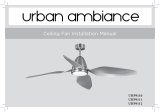 urban ambiance UHP9110 Installation guide
urban ambiance UHP9110 Installation guide
-
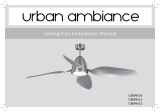 urban ambiance UHP9112 Installation guide
urban ambiance UHP9112 Installation guide
-
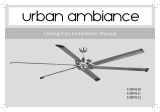 urban ambiance UHP9132 Installation guide
urban ambiance UHP9132 Installation guide
-
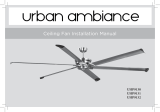 urban ambiance UHP9130 Installation guide
urban ambiance UHP9130 Installation guide
-
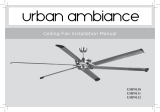 urban ambiance UHP9131 Installation guide
urban ambiance UHP9131 Installation guide
-
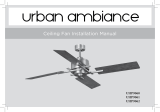 urban ambiance UHP9060 Installation guide
urban ambiance UHP9060 Installation guide
-
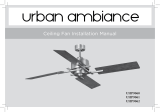 urban ambiance UHP9062 Installation guide
urban ambiance UHP9062 Installation guide
-
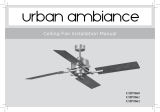 urban ambiance UHP9061 Installation guide
urban ambiance UHP9061 Installation guide
-
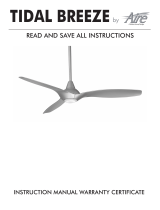 Aire a Minka Group Design 04661 Operating instructions
Aire a Minka Group Design 04661 Operating instructions
-
Minka-Aire F745-BN Operating instructions








































